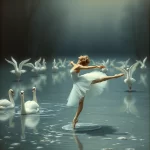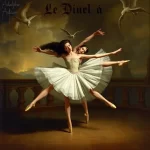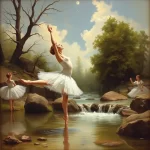Ballet: Swan Lake (Pyotr Ilyich Tchaikovsky, 1877)

Introduction
Ballet, an art form that combines music, dance, and storytelling, has produced some of the most enduring works in the history of performing arts. Among these, “Swan Lake,” composed by Pyotr Ilyich Tchaikovsky and choreographed by Julius Reisinger, stands as a monumental achievement. Premiering on March 4, 1877, at the Bolshoi Theatre in Moscow, “Swan Lake” has captivated audiences for over a century with its hauntingly beautiful music and intricate choreography. The ballet tells the story of Prince Siegfried, who falls in love with Odette, a princess turned into a swan by an evil sorcerer’s curse. The themes of love, betrayal, and redemption are woven into a narrative that has become a cornerstone of classical ballet.
Historical Background
Creation and Development
“Swan Lake” was created during a period of significant cultural and artistic development in Russia. The late 19th century was a time when Russian ballet was beginning to establish its own identity, distinct from its Western European counterparts. Tchaikovsky, already a renowned composer, was inspired by Russian and German folklore, particularly the tale of the swan maiden, a mythical creature found in various cultures. The collaboration between Tchaikovsky and Reisinger, although initially fraught with challenges, eventually led to the creation of a ballet that would become iconic. The involvement of other key figures, such as the librettists Vladimir Begichev and Vasily Geltser, also played a crucial role in shaping the narrative and structure of the ballet.
Premiere and Reception
“Swan Lake” premiered on March 4, 1877, at the Bolshoi Theatre in Moscow. The initial reception was lukewarm, with critics and audiences finding fault with the choreography and the performance of the dancers. Despite this, the music was praised for its emotional depth and complexity. Notable early performances included those by ballerinas Pelageya Karpakova and Anna Sobeshchanskaya, who brought their own interpretations to the role of Odette. The ballet underwent several revivals and revisions, with the most significant being the 1895 production by Marius Petipa and Lev Ivanov, which solidified “Swan Lake” as a masterpiece of classical ballet.
Synopsis of the Ballet
Act I Summary
The ballet opens with Prince Siegfried celebrating his coming of age with a grand party at the royal castle. His mother, the Queen, reminds him that he must choose a bride at the upcoming ball. Distraught by the pressure to marry, Siegfried escapes to the forest with his friends for a hunting expedition. There, he encounters a flock of swans and is mesmerized by their beauty. As night falls, he is left alone by a lake, where he meets Odette, the Swan Queen. She reveals that she and her companions are under a spell cast by the evil sorcerer Rothbart, which turns them into swans by day and humans by night. Siegfried vows to break the curse by declaring his eternal love for Odette.
Act II Summary
In Act II, the scene shifts to the royal ball, where Siegfried is expected to choose a bride. Various princesses dance for him, but he remains uninterested, his thoughts consumed by Odette. Suddenly, Rothbart arrives with his daughter Odile, who has been magically disguised to look like Odette. Siegfried, deceived by her appearance, declares his love for Odile and pledges to marry her. Rothbart triumphantly reveals the deception, and Siegfried realizes his mistake. Devastated, he rushes back to the lake to find Odette.
Finale
The final act takes place at the lake, where Odette forgives Siegfried for his betrayal. Together, they confront Rothbart in a dramatic showdown. Depending on the production, the ballet concludes with either a tragic or redemptive ending. In some versions, Siegfried and Odette perish together, breaking the curse through their sacrifice. In others, they defeat Rothbart and live happily ever after. The conclusion underscores the themes of love and sacrifice, leaving a lasting impact on the audience.
Musical Composition
Composer’s Role
Pyotr Ilyich Tchaikovsky, one of Russia’s greatest composers, brought his unique musical genius to “Swan Lake.” His score is renowned for its emotional depth, melodic richness, and orchestral color. Tchaikovsky’s ability to convey the narrative through music is evident in the ballet’s most famous pieces, such as the “Swan Theme” and the “Dance of the Little Swans.” His contribution to the ballet extends beyond mere accompaniment; the music is integral to the storytelling, enhancing the emotional and dramatic arcs of the characters.
Musical Themes and Motifs
“Swan Lake” is characterized by recurring musical themes and leitmotifs that represent characters and emotions. The “Swan Theme,” a hauntingly beautiful melody, symbolizes Odette and her plight. The music for Rothbart is dark and menacing, reflecting his malevolent nature. Tchaikovsky’s use of leitmotifs helps to unify the ballet’s narrative and provides emotional continuity. The music not only supports the dance but also deepens the audience’s connection to the story and characters.
Famous Recordings and Performances
Over the years, “Swan Lake” has been recorded and performed by numerous renowned orchestras and ballet companies. Iconic recordings include those by the Vienna Philharmonic Orchestra conducted by Herbert von Karajan and the London Symphony Orchestra conducted by André Previn. Notable performances have been staged by the Bolshoi Ballet, the Mariinsky Ballet, and the Royal Ballet, each bringing their own interpretation to Tchaikovsky’s timeless score.
Choreography and Dance
Choreographer’s Vision
Julius Reisinger, the original choreographer of “Swan Lake,” aimed to create a ballet that combined technical prowess with expressive storytelling. Although his initial choreography was not well-received, subsequent revisions by Marius Petipa and Lev Ivanov transformed the ballet into a masterpiece. Petipa’s vision emphasized precision and grandeur, while Ivanov’s contributions brought lyrical beauty and emotional depth to the dance sequences. Their combined efforts resulted in a choreography that has become the gold standard for classical ballet.
Signature Dance Numbers
“Swan Lake” features several iconic dance numbers that have become synonymous with the ballet. The “Pas de Deux” between Siegfried and Odette is a highlight, showcasing the emotional intensity and technical skill of the dancers. The “Dance of the Little Swans,” with its intricate footwork and synchronization, is another standout moment. These dance numbers not only display the choreographic brilliance but also serve to advance the narrative and develop the characters.
Notable Interpretations
Over the years, different productions of “Swan Lake” have brought unique interpretations to the choreography. Some have emphasized the romantic and tragic elements, while others have focused on the fantastical and supernatural aspects. Notable interpretations include those by Rudolf Nureyev, who introduced psychological depth to the characters, and Matthew Bourne, who reimagined the ballet with an all-male cast. These adaptations demonstrate the versatility and enduring appeal of “Swan Lake.”
Characters and Roles
Main Characters
- Prince Siegfried: The protagonist, a young prince who falls in love with Odette and vows to break her curse.
- Odette: The Swan Queen, a princess turned into a swan by Rothbart’s curse. She embodies purity and grace.
- Rothbart: The evil sorcerer who curses Odette and her companions. He is the primary antagonist.
- Odile: Rothbart’s daughter, who deceives Siegfried by posing as Odette.
Supporting Characters
- The Queen: Siegfried’s mother, who pressures him to choose a bride.
- Benno: Siegfried’s friend, who accompanies him on the hunting expedition.
- The Swans: Odette’s companions, who share her fate and transformation.
Famous Dancers
Many renowned dancers have portrayed the roles in “Swan Lake,” bringing their own interpretations and styles to the characters. Notable Odette/Odile performers include Anna Pavlova, Galina Ulanova, and Natalia Makarova. Rudolf Nureyev and Mikhail Baryshnikov are among the celebrated dancers who have portrayed Prince Siegfried. These performers have left an indelible mark on the ballet, contributing to its legacy and enduring popularity.
Cultural and Artistic Impact
Influence on Ballet and Dance
“Swan Lake” has had a profound influence on the world of ballet and dance. Its success paved the way for other narrative ballets and established Tchaikovsky as a leading composer for ballet. The choreography by Petipa and Ivanov set new standards for technical excellence and artistic expression. The ballet’s themes and motifs have inspired countless choreographers and dancers, making it a cornerstone of classical ballet repertoire.
Cultural Significance
Beyond the world of dance, “Swan Lake” has permeated popular culture, literature, and other media. It has been referenced in films, television shows, and books, often symbolizing beauty, tragedy, and transformation. The ballet’s iconic imagery, such as the swan costumes and the moonlit lake, has become ingrained in the cultural consciousness. Adaptations in film and theater, such as Darren Aronofsky’s “Black Swan,” have brought new interpretations and audiences to the classic tale.
Legacy and Revivals
“Swan Lake” continues to be performed and celebrated worldwide, with major revivals and reinterpretations keeping the ballet fresh and relevant. Companies like the Bolshoi Ballet, the Mariinsky Ballet, and the Royal Ballet regularly stage productions, each bringing their own unique vision to the work. Modern adaptations, such as Matthew Bourne’s all-male version, demonstrate the ballet’s versatility and enduring appeal. The legacy of “Swan Lake” is a testament to its timeless beauty and emotional power.
Iconic Productions
Historic Productions
Several historic productions of “Swan Lake” have left a lasting impact on the ballet’s legacy. The 1895 revival by Marius Petipa and Lev Ivanov at the Mariinsky Theatre is perhaps the most significant, as it established the choreography and structure that are still used today. Other notable productions include those by the Bolshoi Ballet in the mid-20th century, which featured legendary dancers like Galina Ulanova and Maya Plisetskaya.
Contemporary Productions
Recent productions of “Swan Lake” have brought new interpretations and innovations to the classic ballet. Companies like the Royal Ballet and American Ballet Theatre have staged acclaimed performances that blend traditional choreography with modern sensibilities. Contemporary choreographers, such as Matthew Bourne, have reimagined the ballet in bold new ways, introducing fresh perspectives and attracting new audiences.
Production Design
The production design of “Swan Lake” plays a crucial role in creating the ballet’s enchanting atmosphere. Set designs often feature a moonlit lake, dark forests, and opulent royal ballrooms, enhancing the narrative’s magical and dramatic elements. Costume designs, particularly the iconic swan costumes, are essential in conveying the characters’ transformation and grace. Lighting design also contributes to the mood, with soft, ethereal lighting for the lake scenes and vibrant, dynamic lighting for the ball.
Critical Reception and Reviews
Initial Critical Response
The initial critical response to “Swan Lake” was mixed, with many critics finding fault with the choreography and performance. However, Tchaikovsky’s music was widely praised for its emotional depth and complexity. Over time, as the choreography was revised and improved, the ballet gained greater acclaim and recognition.
Modern Reviews
Today, “Swan Lake” is universally regarded as a masterpiece of classical ballet. Contemporary critics and audiences continue to be captivated by its emotional power, technical brilliance, and timeless beauty. The ballet’s enduring popularity is a testament to its artistic excellence and cultural significance.
Fun Facts and Trivia
Behind-the-Scenes Stories
One interesting anecdote from the original production involves Anna Sobeshchanskaya, who was dissatisfied with Reisinger’s choreography for her solo. She traveled to St. Petersburg to work with Marius Petipa, who created a new solo for her. This solo was later incorporated into the 1895 revival by Petipa and Ivanov.
Notable Performers
Many famous dancers have left their mark on “Swan Lake.” Anna Pavlova, one of the most celebrated ballerinas of all time, was known for her exquisite portrayal of Odette. Rudolf Nureyev and Mikhail Baryshnikov, two of the greatest male dancers in history, have both performed as Prince Siegfried, bringing their own unique interpretations to the role.
Trivia
- The original 1877 production of “Swan Lake” was not an immediate success, but it has since become one of the most performed ballets in the world.
- Tchaikovsky’s score for “Swan Lake” was one of the first to be written specifically for a ballet, rather than adapted from existing music.
- The “Dance of the Little Swans” is one of the most technically challenging pieces in classical ballet, requiring perfect synchronization and precision from the dancers.
Conclusion
Summary of the Ballet’s Importance
“Swan Lake” is a cornerstone of classical ballet, renowned for its emotional depth, technical brilliance, and timeless beauty. The collaboration between Tchaikovsky, Petipa, and Ivanov resulted in a work that has captivated audiences for over a century. Its influence on ballet and dance is profound, inspiring countless choreographers, dancers, and artists.
Final Thoughts
“Swan Lake” remains a testament to the power of art to transcend time and culture. Its themes of love, betrayal, and redemption continue to resonate with audiences today. Whether experienced through a live performance or a recording, “Swan Lake” offers a glimpse into the sublime beauty and emotional depth of classical ballet. For those who have yet to experience it, watching a performance or listening to Tchaikovsky’s score is highly recommended.
FAQ
What is the central theme of this ballet?
The central theme of “Swan Lake” is the struggle between good and evil, love and betrayal, and the quest for redemption.
Who are the main characters in this ballet?
The main characters are Prince Siegfried, Odette (the Swan Queen), Rothbart (the evil sorcerer), and Odile (Rothbart’s daughter).
What is the most famous dance number in this ballet?
The “Dance of the Little Swans” is one of the most famous and recognizable dance numbers in “Swan Lake.”
How long does a typical performance of this ballet last?
A typical performance of “Swan Lake” lasts approximately two to three hours, including intermissions.
Are there any modern adaptations of this ballet?
Yes, there are several modern adaptations of “Swan Lake,” including Matthew Bourne’s all-male version and various contemporary reinterpretations by different ballet companies.
Why is this ballet considered important in the history of dance?
“Swan Lake” is considered important in the history of dance due to its groundbreaking choreography, emotional depth, and Tchaikovsky’s innovative score. It has set the standard for classical ballet and continues to inspire and influence the art form.





